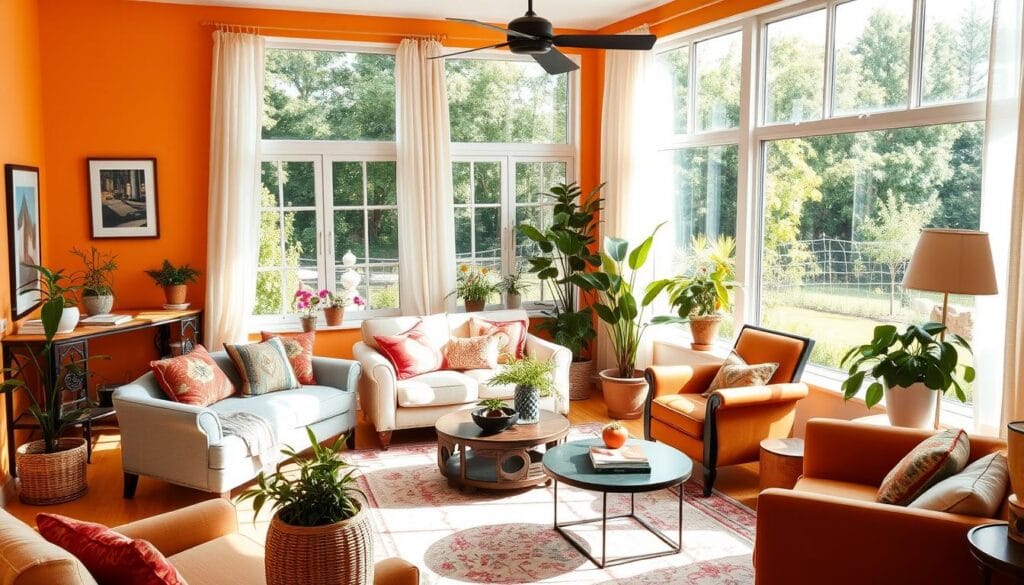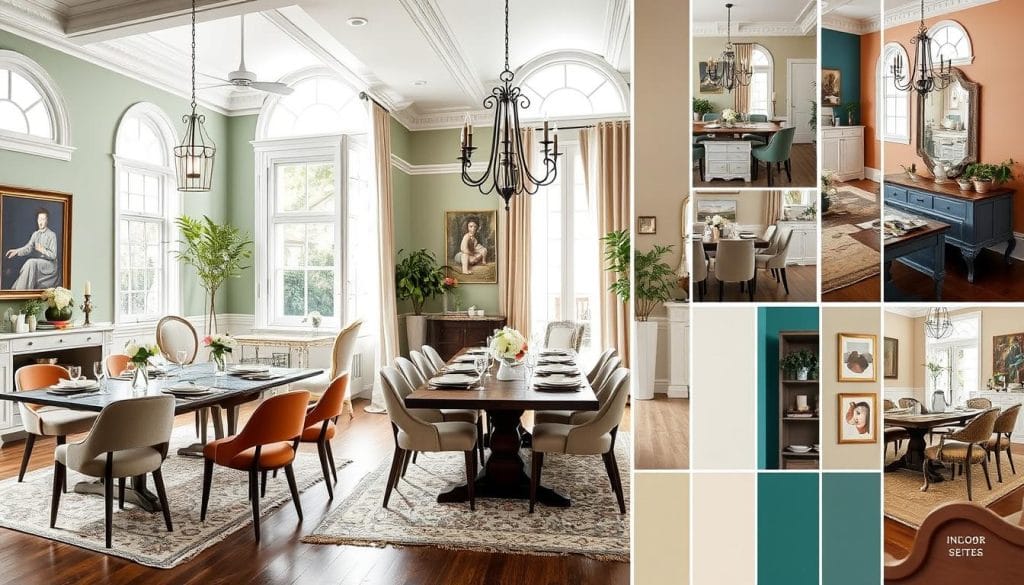Have you ever walked into a room and felt immediately uplifted, or maybe even relaxed? That’s the magic of color at work! We wanted to brighten up our living room, which had dull beige walls. They didn’t show off our personality. After looking around, we found a vibrant teal that made us happy!
The room’s transformation was stunning. It became bigger, brighter, and cozier at the same time. This change impacted how we felt in our home. Picture changing your home with simple paint ideas you’ll adore! Paint opens up lots of DIY projects. They’re not just fun but easy on your wallet too, letting you upgrade your space in beautiful ways.
So, if you’re aiming to bring energy to your kitchen with warm colors or turn your bedroom into a calm spot with gentle tones, let’s dive into using colors and techniques to mirror your personal style!
Understanding Color Theory and Its Importance
Color theory is key to improving our homes. It uses the color wheel to help us pick colors well. These choices make our spaces welcoming. By using warm colors and cool colors, we can change how a room feels. Let’s explore important ideas and how they help in making color palettes for home decor.
The Color Wheel: Primary, Secondary, and Tertiary Colors
The color wheel helps us see how colors relate. It includes:
| Type | Examples |
|---|---|
| Primary Colors | Red, Blue, Yellow |
| Secondary Colors | Green, Orange, Purple |
| Tertiary Colors | Red-Orange, Yellow-Green, etc. |
Knowing these groups helps us in DIY projects. We can make a space look good by picking colors that match or contrast. For example, a cohesive palette is easy to achieve this way.
Warm vs. Cool Colors: Setting the Mood
Choosing colors affects a room’s vibe. Warm colors like reds and yellows add life. They’re great for lively places like living rooms. On the other hand, cool colors like blues and greens are peaceful. They’re best for quiet spots like bedrooms. Mixing these colors well can make a place feel just right.
Complementary Colors: Creating Balance in Design
Complementary colors are opposite on the color wheel. They make rooms lively and balanced. Using them highlights and enhances features. This method works well for accent walls or decor. It makes designs stand out and look better.
Selecting the Right Paint Finish for Your Space
Choosing the right paint finish is crucial for your home’s look and feel. Each finish has its own benefits for different areas. Knowing about gloss, satin, and eggshell helps us design spaces that are beautiful and useful.
Gloss, Satin, Eggshell: What Do They Mean?
Paint finishes differ in how shiny they are:
- Gloss finishes are shiny, making colors vivid. They work well in busy spots like kitchens and bathrooms. They are easy to clean and resist stains.
- Satin finishes have a slight shine, balancing toughness and beauty. They’re good for living areas and halls, being easy to clean without being too shiny.
- Eggshell finishes are less shiny, suited for bedrooms and quiet places. They hide wall flaws and create a cozy feeling.
Choosing the Best Finish for Different Rooms
Knowing which finish to use where is key:
| Room Type | Recommended Finish | Reasoning |
|---|---|---|
| Kitchens | Semi-Gloss | It’s durable and simple to clean, standing up to moisture and stains. |
| Bathrooms | High-Gloss | Great for humid areas and easy cleaning. |
| Living Rooms | Eggshell or Satin | Brings warmth and covers minor wall issues. |
| Hallways | Satin | Can handle lots of foot traffic and looks good. |
| Bedrooms | Matte or Eggshell | Makes spaces feel cozy and soft. |
We can make our homes stylish and functional by understanding these finishes. Let’s choose the perfect colors for our next makeover! 🎨
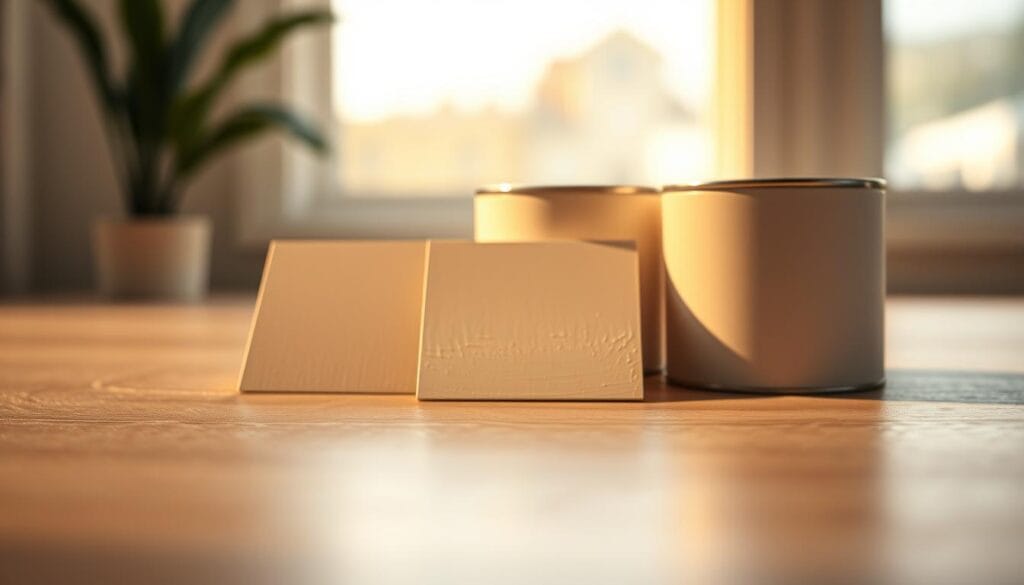
Psychological Effects of Color in Home Decor
Color in home decor shapes how we feel in our spaces. Each color brings something special. From making shared areas cozy to making private spots peaceful. Knowing about warm, cool, and neutral colors can improve how we design inside.
Warm Colors and Their Inviting Nature
Warm colors are reds, oranges, and yellows. They make us feel cozy and ready to connect. These colors can add energy and help people come together. Yellow brings happiness and creativity. It’s great for where we eat and cook.
Red sparks conversation and energy. Orange boosts excitement, great for fun or fitness areas. Using these colors just right makes spaces welcoming but not too intense.
Cool Colors for Calming Spaces
Cool colors include blues, greens, and purples. They help us relax. Blue helps reduce stress. It’s perfect for where we sleep and bathe. Green brings balance and life, ideal for living spaces and work areas.
Purple adds a touch of luxury, good for places where we chill and create. Mixing cool and warm tones improves our mood and keeps the look unified.
Neutral Shades: Versatility and Timelessness
Neutral colors, like white, beige, and gray, give freedom in decor. They highlight other colors. White means clarity and simplicity. Beige is calming and mixes well with bold colors. Gray is neutral and classy, a backdrop for bright colors.
Using neutrals makes changing decor easy. And it makes your style last longer. They’re key for a design that stays fresh over time.
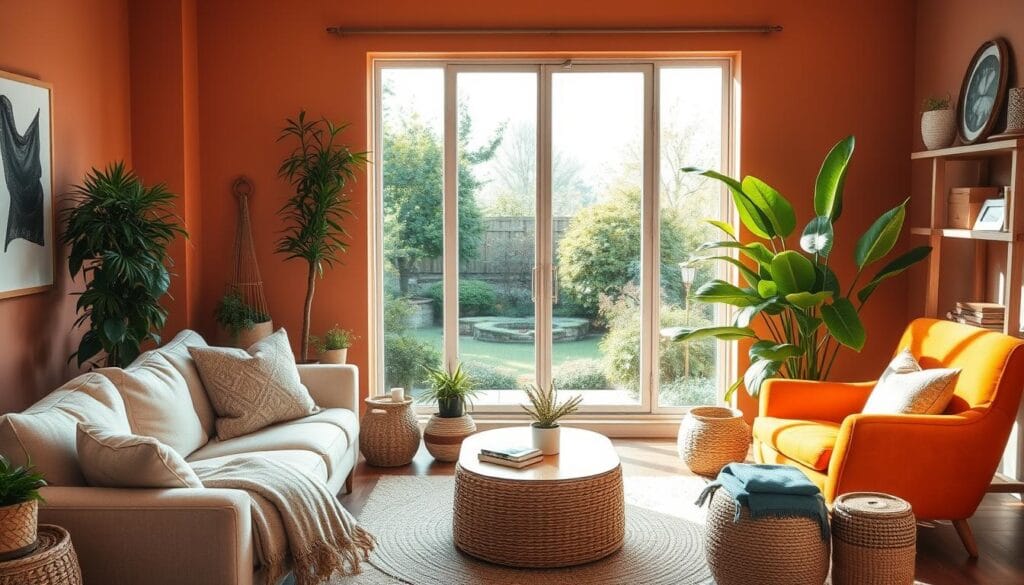
The Art of Accent Walls: Making a Statement
Adding an accent wall can transform any space. It brings depth and character without making things too busy. The key is finding the ideal wall, one that catches the eye, to highlight. By using different painting methods, you can make this wall stand out and improve your home’s vibe.
Choosing the Perfect Wall for Accenting
Finding the right wall for your accent is essential. Look for areas that are already focal points, like behind furniture or noticeable spots. Remember, accent walls work great in living rooms, bedrooms, or offices. Choosing colors like terracotta or charcoal gray can make your space feel cozy and inviting.
Techniques for a Flawless Finish
Creative painting techniques can define your accent wall. Textures like lime wash or Venetian plaster add depth while keeping things balanced. Using bold colors can bring a dramatic look. Textured paints are popular among those wanting to enhance their rooms. For tips on picking colors, visit this site.
Combining Patterns and Textures
Mixing different patterns and textures can elevate your accent wall. Geometric shapes offer a modern touch to traditional spaces. Meanwhile, floral patterns are back, perfect for those who love a touch of elegance and warmth. Consider adding 3D elements like wooden slats or magnetic surfaces for a lively and interactive home atmosphere.
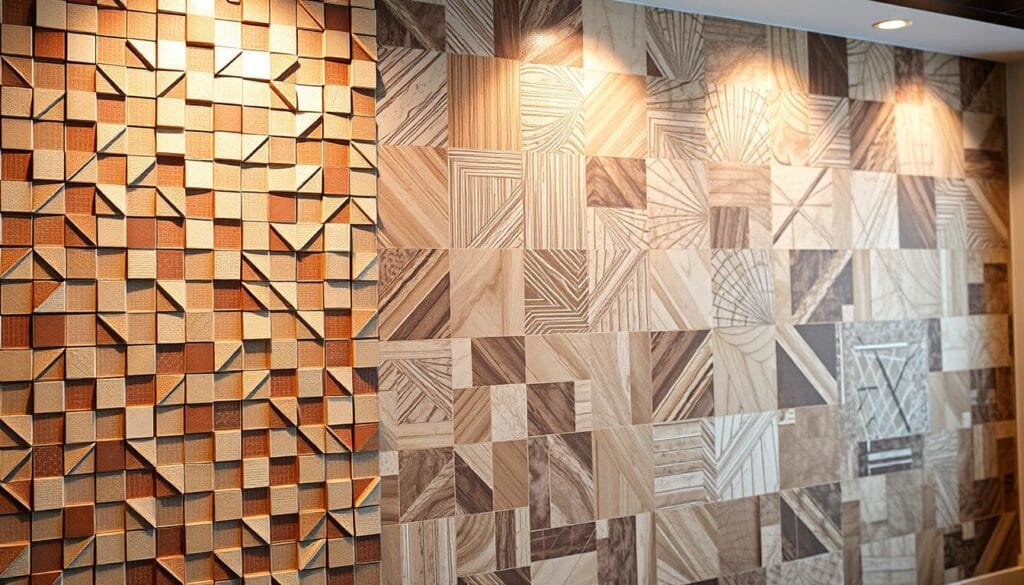
Prep Work: Essential Steps Before Painting
Starting a painting project means you need to prepare well for amazing results. Taking time to prep your surfaces really changes how well your project turns out. Cleaning walls and using the right taping methods are key for a perfect finish.
Cleaning and Repairing Wall Surfaces
Cleaning walls is very important. If walls are dirty, the paint won’t stick well. Kitchens and hallways might need more cleaning because they get dirty faster. In places near the sea, it’s crucial to remove salt. A tip: using a pressure washer can clean surfaces really well! After cleaning, fixing any cracks or holes is next. This step makes sure your painting surface is smooth. Doing this can make your paint last 30% longer!
Taping and Covering Fixtures: Best Practices
Once cleaning and fixing are done, it’s time to tape off areas. Painter’s tape helps stop unwanted paint marks and makes edges sharp. Always tape around fixtures and areas you don’t want to paint. Don’t forget to put down drop cloths to catch any spills. Following these steps makes painting smoother and more fun. Putting in the effort beforehand makes the end result truly worth it!
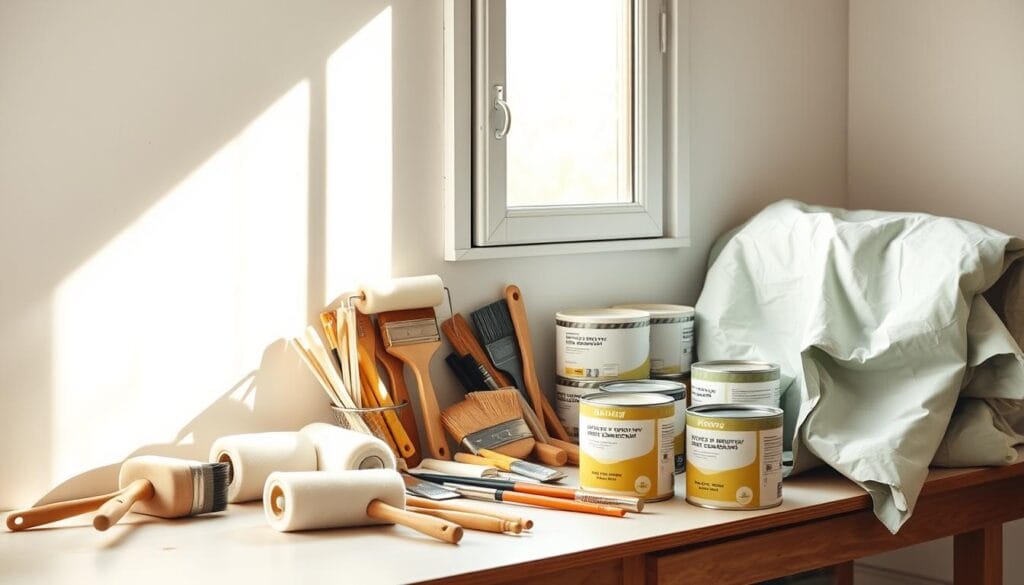
Budget-Friendly Painting Techniques
Refreshing your home can be affordable! Everyone loves a newly painted area. It brings a sense of freshness. You don’t have to spend much to achieve this new look. It’s all about choosing between DIY or professional help. Also, try out some creative upcycling. Let’s look at ways to make your home look better while saving money.
DIY vs. Hiring Professionals
Choosing DIY or professional painters depends on your budget. DIY can save you a lot of money, up to 75% less! If you like doing things yourself, finishing a paint job feels great. Plus, with good preparation and tools, you can get amazing results on your own.
Upcycling: Giving Old Furniture a Fresh Coat
Upcycling is a great way to revive old furniture. A new paint job can really change a piece’s look and improve your decor. For example, painting kitchen cabinets can increase your home’s value by 80-100% if you decide to sell. And, you don’t need to spend much to make something look special. Just a few simple paint techniques can transform an outdated piece into something eye-catching.
Creative Ideas for Small Spaces on a Budget
Small areas are perfect for creative painting. Choosing bright colors or an accent wall can make a space seem bigger and welcoming. An accent wall means you need less paint—about 30% less. This saves money. Adding color to corners or small sections changes the feel without costing a lot. High-quality tools help apply paint smoothly, requiring fewer coats and saving both time and money.
Advanced Painting Techniques to Elevate Your Home
Homeowners aiming to stand out can explore advanced painting skills. These include faux finishes, allowing you to mimic materials like marble or wood grain. By doing this, you get a luxurious look while saving money.
Faux Finishes: Marble, Wood, and More
Faux finishes offer a way to turn plain surfaces into something special. We can use glazing and sponging to add interesting textures. Imagine your walls looking like elegant marble or cozy wood. It’s quite magical!
Sponge and Rag Techniques: Adding Depth
Looking to add depth to your walls? Sponge painting creates lovely, mottled patterns, great for nurseries or dining areas. Rag painting applies color gently, giving rooms personality without complex patterns. These techniques bring a gentle sophistication.
Stenciling: Personalizing Your Decor
Stenciling lets you add a personal touch to your home. You can choose custom patterns that show off your style. This way, whether it’s intricate or bold, your interior decor will truly be one-of-a-kind.

Eco-Friendly Painting Options for Sustainable Living
More people are thinking about their impact on the planet. Eco-friendly painting is key for a greener home. It uses low-VOC and zero-VOC paints to make our homes look great and the air cleaner. This is especially good for families and pets, making homes safer and more sustainable.
Low-VOC and Zero-VOC Paints Explained
Low-VOC paints have fewer harmful chemicals than standard paints. Some have less than 50 grams of VOCs per liter. They make the air inside better and cut down on pollution. Zero-VOC paints go even further, with no harmful VOCs at all. They’re the best pick where kids and pets hang out.
Making Environmentally Conscious Choices
Look for paints that use natural or recycled materials. Natural paints come from plants and minerals, avoiding toxic stuff. Recycled paints reuse post-consumer waste, lessening their environmental toll.
- Choose eco-friendly primers for better adhesion and healthier indoor air.
- Look at coverage to use fewer coats, which reduces waste.
- Pick brushes or rollers over power tools to save energy and cut pollution when painting.
Buy reusable items like quality brushes, rollers, and drop cloths. They last longer and cut down on trash. Cleaning tools with water or green cleaners prevents bad stuff from polluting water.
Give away extra paint to local groups or recycling programs. This keeps it out of dumps. Working with green-minded painters helps your project stay eco-friendly. Plus, they share helpful tips during your painting adventure.
Maintenance Tips for Long-Lasting Paint Jobs
After painting, the next step is keeping that new look. Proper maintenance helps our work last longer. Regularly cleaning painted surfaces is doable for us. Using gentle cleaning products helps remove dirt and mildew. This keeps the colors bright. In Denver, power washing each year is great for outdoor paint. It refreshes the outside and protects your hard work!
Cleaning Painted Surfaces Safely
Using the right cleaning methods is key. Light colors like white and cream can reflect sunlight. This reduces UV damage and keeps them looking new. Choose cleaners that match your paint’s finish. Semi-gloss paint can handle more tough cleaning. It’s perfect for places with a lot of people coming and going.
Touch-Up Techniques That Blend Seamlessly
Being good at touch-ups is as important as the first coat of paint. If you see chips or color changes, fix them fast. Make sure your touch-ups blend well with the rest. This means using the same paint color and applying it just like before. Checking for problems regularly helps your space stay beautiful. Your home will look welcoming for many years!

